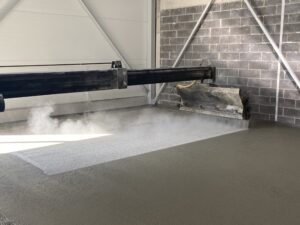Concrete floor hardeners
Concrete floor hardeners are commonly applied to the surface of freshly placed or already hardened concrete to improve wear resistance. They decrease typical plain concrete negative properties like dusting and liquid absorption by improving the abrasion resistance and reducing surface permeability. Concrete hardeners are used mostly in industrial floors but also in commercial and living rooms. There are also decorative screeds options available.
General information about surface hardeners:
Special coating agents referred to as surface hardeners can be used to improve the strength and appearance of the surface layer of concrete floors. The purpose of a surface hardener is to extend the service life of a floor, increasing its resistance to external factors. Floor hardeners are dry mixtures which are installed on freshly poured concrete substrate as dry shake or as a separate layer mixed with water. Surface hardeners can also be installed on an existing hardened substrate and used for repairing and renovation of floors. The Korodur surface hardeners offered by Betotrade OÜ consist of carefully selected mineral aggregates of a high durability and portland cement. Coloured floor hardeners are also available.
Properties of hardeners:
- Increase resistance to wear resistance
- Increase resistance to impacts
- Reduce the porosity and water absorption of the surface
- Higher resistance to chlorides, oils, fuels, etc.
- Not corrosive or flammable
- In the case of fibre-reinforced concretes, cover the steel fibres on the surface
The areas of application of hardeners:
-
warehouses and production buildings
- sales areas, offices
- public buildings
- residential houses
- multi-storey car parks, garages
- cold storages
Requirements for hardeners:
The requirements for the technical properties of surface hardeners are specified in EVS-EN 13813:2005. The most important property of a surface hardener is its wear resistance. The manufacturer must declare the durability indicators. Wear resistance is determined based on EN 13892-3 (the Böhme method) or EN 13892-4 (the BCA method). Based on the Böhme method, wear resistance is marked with the letter ‘A’ which is followed by the numerical wear loss (cm³/50cm²). The lower the figure after the ‘A’, the higher the durability of the surface hardener.
The Böhme wear resistance classes based on EVS-EN 13813:2005 are
| Class | A22 | A15 | A12 | A9 | A6 | A3 | A1,5 |
| Wear loss – cm³/50cm². | 22 | 15 | 12 | 9 | 6 | 3 | 1,5 |
The wear resistance based on the BCA method is marked with the ‘AR’ (Abrasion Resistance) letter combination, followed by the maximum 100 µm fold wear depth
BCA kulumiskindlusklassid EVS-EN 13813:2005 kohaselt
| Class | AR6 | AR4 | AR2 | AR1 | AR0,5 |
| Maximum wear depth µm | 600 | 400 | 200 | 200 | 50 |
The assortment of surface hardeners offered by Betotrade OÜ includes products for all wear resistance classes.
Methods of installation of surface hardeners:
The Korodur hardeners offered by Betotrade have a good bond. The surface hardeners are mostly installed on freshly cast concrete as dry shake powder, either by using a spreading trolley or a special spreader. The sooner the installation works begin, more the material can be installed and the sturdier the final surface of the floor. The standard consumption in the case of spreading is 3-5kg/m². In the case of a renovated floor, a hardener is used as a mortar mixed with water and the thickness of the layer applied is in this case approximately 12 mm. If you would like to create a more special floor, our product selection also includes coloured hardeners. In the case of installing on an existing floor as a separate layer, there is a choice of the finishing of a troweled concrete floor (Korodur KCF) or terrazzo (Granidur).







